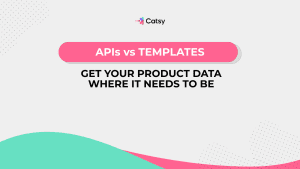The Essential Role of Robust Product Content for eCommerce Conversions and PDF Sales Catalogs

- Robust product content is crucial for eCommerce success, influencing conversions and customer satisfaction.
- PDF sales catalogs remain valuable tools in the digital age, offering centralized, organized product information.
- Catsy DAM & PIM streamline product content management, providing a single source of truth for businesses.
In this Article
Imagine a shopper is searching for a product online. They bounce from one website to another, comparing prices and customer reviews. After a thorough search, they finally decide on a particular website to make their purchase. But they click on the product page only to be met with incomplete, confusing, or outdated information.
The product page features low-quality images, the product description is so vague it leaves them scratching their head, and critical specifications are not there. As a result, they abandon the website without making a purchase.
This is where managing an eCommerce product catalog comes into play.
As an online seller, you aim to provide customers with a hassle-free and enjoyable shopping experience. You want them to explore and buy the items they need without any hassle. And, of course, these must appear at the top of search engine results in order to drive more traffic, conversions, and sales.
This article will cover how robust product content can boost eCommerce conversions and why PDF sales catalogs are essential to achieving success in online selling. But first, let’s understand how content affects or improves conversions.

The Impact of Robust Product Content on eCommerce Conversions
Have you ever wondered why some online stores have higher visitor and conversion rates than others? One reason is that product content quality leads to eCommerce conversions.
The buyer journey starts with search engines, seeking items. Consequently, search engines are constantly crawling websites for information. Well-structured content and accurate data help search engine crawlers understand them better. This, in turn, boosts your website’s visibility in search results, bringing more organic traffic.
Moreover, robust product content keeps customers engaged and informed. Customers are more likely to make educated purchase decisions when they have all the required product information. This means higher sales and fewer returns, as customers can match what they received to what they saw online. If you don’t believe us, check out the facts:
– 85% of shoppers agree product information and pictures are vital when deciding which brand or retailer to buy from.
– Nearly 87% of consumers rate product content extremely or very important when buying.
– 56% of users return online purchases due to mismatched descriptions.
In short, robust product content attracts potential customers and helps them confidently click the “Buy Now” button.

Creating Compelling eCommerce Content to Boost SEO and Conversions
Creating compelling eCommerce content is about writing a product copy that sells. A study by eMarketer shows that over 80% of the respondents said descriptions influence their purchase decisions. Hence, write engaging descriptions to make the most out of the content.
Here are some strategies and techniques to improve the product content.
Know Your Audience
The first step to convincing someone to buy your products is understanding their needs, wants, and desires. If you want your descriptions to persuade your audience, understand them first. Consider the following questions to know your audience and cater to their needs and problems with descriptions.
- What is the age range of your ideal customer?
- What is their educational background and income level?
- What pain point does your item help them solve?
- Do they live in urban areas, suburbs, or rural communities?
- Are they adventurous, practical, or tech-savvy?
Once you know these things, you can talk to them about the item in a way that makes sense and includes all the features that solve their concerns.
Optimize Product Pages for Search Engines (SEO)
Besides giving your customer insight into your product, your description section is also an opportunity to rank high on search engine results pages (SERPs).
When your pages are SEO-oriented, your brand might get noticed more online, leading to increased sales.
For this, you must focus on on-page SEO for your pages. This includes using keywords relevant to your item in descriptions and metadata. These keywords are words or phrases that people often search for when finding products like yours.
The easiest way is to use tools like Ahrefs’ Keywords Explorer or Google Keyword Planner and look for related terms. They display keywords with their search volume and ranking.
For example, if you want to sell a black dress, it will show all related terms people often search for. Such as little black dress, cocktail black dress, black dress for women, etc.
Avoid Vague Phrases
Vague phrases and adjectives like “excellent quality” are not enough to convince shoppers to purchase. Consumers know that no online sellers usually admit if their items aren’t good, so it’s important not to say “quality” outright. Instead, describe what the product can do and how it can help your audience.
For instance, Zappos doesn’t describe the quality of a pair of shoes as excellent. Instead, they define each technical detail and its benefits.
These details do not highlight the quality directly, but they offer an impression of quality. An easy pattern to follow is highlighting 1 feature + 1 benefit:
- Leather and textile upper for added frontal detail
- Memory foam footbed for all-day comfort
Further, you can use words that appeal to the senses to make descriptions more enticing. You can also use action words to make the description more exciting and ensure writing correct grammar for credibility.
Make Your Product Description Scannable
A product description with perfect language won’t matter if website visitors do not read it. Statistics reveal that 79% of people don’t read the full descriptions but scan them.
Making the descriptions more scannable with bullet points can increase readability. Use formatting to grab the audience’s attention to the crucial details. Utilizing white space on the page also makes content more readable. Consider how your descriptions look in the page layout with product images to improve conversions.
Use High-Quality Images
Quality images are essential companions to convincing descriptions. According to studies, 67% of consumers say the quality of a product image is “very important” in selecting and purchasing. Hence, including appealing images allows website visitors to make a visual connection quickly.
For example, Canon provides quality videos and images to showcase the features of its PowerShot camera. The company includes a close-up shot of the camera in hand to highlight its pocket-friendly design.
Another tip is to capture images from different sides and angles. A 360-degree view helps highlight features otherwise invisible from one perspective.

PDF Sales Catalogs: A Valuable Sales Tool
In today’s digital age, where e-commerce platforms and online marketing dominate the sales landscape, one might wonder if PDF sales catalogs still have a place. And in fact, PDF catalogs remain not only relevant but also a valuable sales tool.
Product catalogs allow you to combine the brand’s top offerings and details in a single repository. Product catalogs are a sales tool easily distributable to existing customers or new audiences across multiple channels.
Catalogs contain all customer-facing details and are invaluable for internal departments in creating campaigns and maintaining brand consistency. Such catalogs typically follow a straightforward structure, featuring regularly updated data, images, and details on where potential buyers can make their purchases.
Creating PDFs for High-Converting Content
Here are some tips to create effective eCommerce content for PDF catalogs.
Research the Target Audience
Before thinking about creating the content, it is necessary to know the target audience. Leverage multiple resources for market research and identify your target customer and prospect’s demographics, interests, and problems. It will help you modify the catalog content that aligns with the target audience and addresses their needs.
Optimize Product Catalog Title
The PDF title is the first thing customers notice. Hence, write a compelling, keyword-focused title and headlines to capture the audience’s attention. You must include relevant keywords that describe the product precisely. Also, ensure the title is to the point and easy to understand.
Engaging Product Descriptions
Interesting descriptions are necessary for conversions. So, ensure your descriptions are factual, appealing, and convincing. Emphasize the primary features and value propositions of your items. Always use clear language and formatting to enhance readability. Leverage customer testimonials, social proof, and relevant credentials to forge credibility.
Compelling Product Images and Videos
We already highlighted the role of images and compelling videos in engagement. Product images and videos provide an interactive experience.
Use images and videos creatively to highlight product characteristics, performance, and benefits. Keep the video brief and entertaining to increase engagement. Also, remember to enhance video thumbnails and add relevant subtitles.
Clear and Compelling Call-to-Action (CTA)
Your content may not drive conversions if it does not direct customers to take action. Hence, guiding potential customers toward purchasing with a call-to-action button is vital.
- You can add CTAs to encourage visitors to click the “Add to Cart” button.
- Create urgency or FOMO with limited-time offers to compel customers to act promptly.
- Use convincing language like “Limited Offer, Buy Now” to drive conversions.
PDF Product Catalog Example
Consider the example of the AlphaBio product catalog. The company provides dental implantology solutions and has been in the dental practice for 30 years. The company’s catalog from 2019 details its design features, items, dimensions, instructions, composite material, and clinical advantages.
The in-depth and well-structured product details of different implants and their specification is vital to educate and inform the target audience.
The catalog covers information for various stakeholders, such as surgeons, patients, dentists, distributors, and partners.
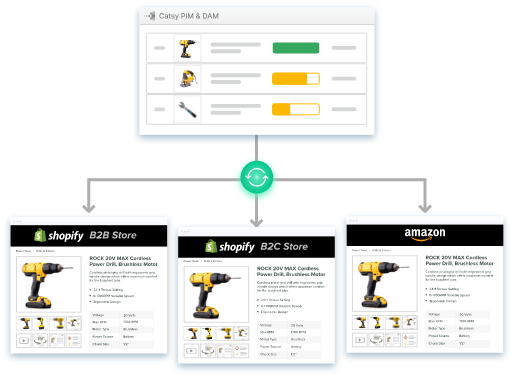
Ensuring Robust Product Content with Catsy DAM & PIM
Streamlining your product attributes and relevant media is crucial to achieving your business objectives. This is where Catsy DAM and PIM offer a valuable combination for eCommerce product management. Let’s find out how Catsy DAM and PIM is the most suitable choice for efficiently managing and distributing content.
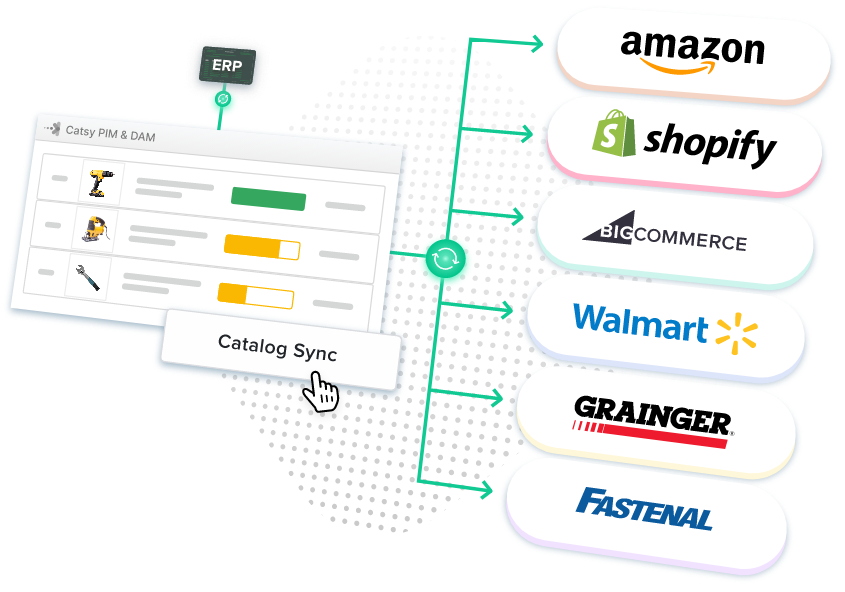
1. Centralization: Single Source of Truth
A single source of truth (SSOT) is a concept in data management that aims to consolidate and store relevant data in a single, centralized location. Employing a single source of truth ensures data remains consistent, accurate, and up-to-date, eliminating the use multiple copies of information.
Catsy’s DAM and PIM store all product and asset information in a centralized system. The integrated solution ensures better content management and organization and helps stakeholders, sales teams, and end users gain access to updated and accurate information.
PIM handling product information and DAM handling digital assets help consolidate information to manage, organize, and distribute it to channels like eCommerce platforms, social media, and print media.

2. Product Categorization / Link Data & Assets
Product categorization or hierarchy refers to the proper arrangement according to their relationship to each other. Similar to biological taxonomy, product hierarchy folds broad categories into smaller, more precise categories. Each category has similar tags or attributes grouped logically to create a purposeful chain of products.
Catsy uses the term “parent-child relationships” to describe such connections. For instance, when navigating an e-commerce website, such as a comprehensive platform like Amazon or eBay, searching for a smartphone case follows a straightforward process.
Beginning with a broad category, Mobiles, for example. The category then narrows down to the Mobile Accessories and, finally, showcases Phone Cases. Such a logical hierarchy makes the search process intuitive and easy to follow for consumers.
Utilizing a PIM solution like Catsy allows you to create taxonomy-led products. This means users can manage items from the most general down to the most detailed attributes in a seamless, organized fashion. Product categorization within Catsy is purpose-built for customization while supporting a solid foundation for cohesive data governance, whether your catalog includes 1,000 or 100,000 SKUs.
In addition to categorizing SKUs and information, Catsy’s built-in eCommerce DAM enables users to categorize images alongside the appropriate item. This creates a full view of your product before publishing to appropriate sales channels and allows for a very powerful search of both products and assets both in Catsy and on eCommerce sites.
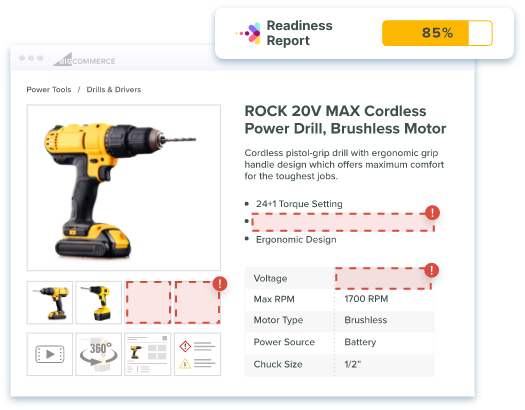
3. Readiness Reporting
Missing product data equals missed opportunities for revenue. Readiness reporting represents one way Catsy simplifies this process for you. Whether embarking on a multi-product update or introducing an entirely new range, Catsy’s readiness reports offer the essential insights to ensure your offerings are ready for the marketplace without missing titles, descriptions, attributes, or images.
The reports offer in-depth insights into the data status, allowing you to make necessary changes or adjustments to ensure all the content is represented. Moreover, with access to all your data sources, you gain a 360-degree view of how all the elements interconnect, ensuring a seamless and logical operation.

4. Validation Tool
Validation tools help define protocols and benchmarks before the distribution of data. It ensures that your product content is void of clear technical errors. For example, if the dimensions of a power drill (after packaging) are listed as 24 in x 240 in, the validation tool will flag the measurement as it is a clear error. This allows marketers or eCommerce managers to quickly catch errors within the data before publishing it to an eCommerce store or a PDF.
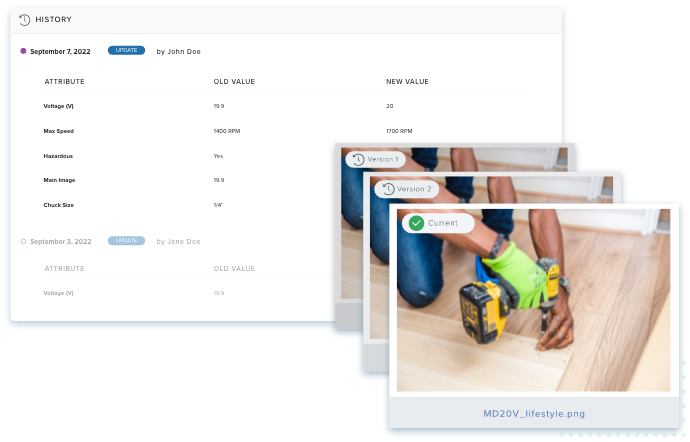
5. Version History
Version history within Catsy helps with monitoring changes as they happen. A significant advantage of this is the ability to identify which pieces of content are the most up-to-date, and who the content has been edited by and when. If working on large teams, for example, if a marketer is waiting on an SEO manager to review descriptions, they can quickly see if this process has been completed before approving any changes.
In the context of DAM, some assets can be lost or manipulated if not governed correctly. Using version history to check if a product image has been updated, by whom, and when is an important security check before publishing assets to stores. You can also access your import history, which is able to diagnose potential conflicts or overrides.
You can preserve the version’s history to save time and enhance team organization by maintaining a record of who made specific changes and when they were made.
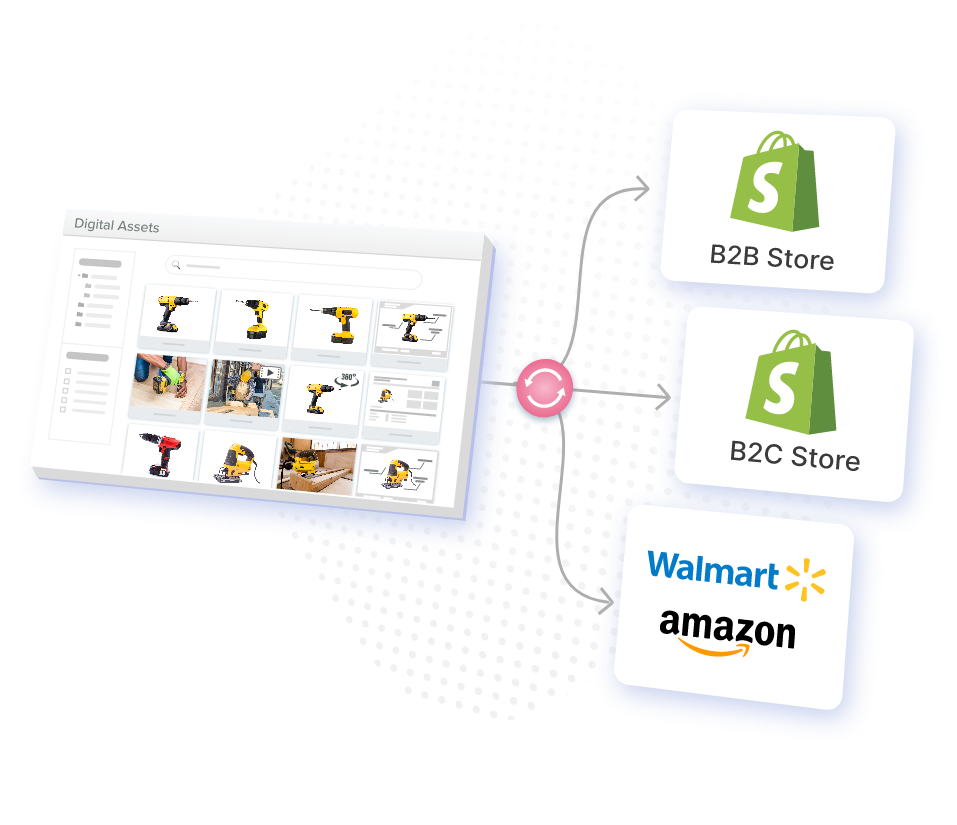
6. Syndication to Shopify, BigCommerce, and Amazon
In eCommerce, syndication refers to publishing product content to a store using an API, Webhook, or FTP. Syndication allows you to publish items without exporting CSVs from your DAM/PIM or Excel and then importing the CSVs to their destination channel. Rather, using Catsy as an example, you can syndicate information and digital assets to your Shopify stores using Catsy’s industry-leading API integration.
7. Customized PDF Generator
Digital customized PDF catalogs improve conversions and provide a dynamic option to share product information.
While a print catalog is still an efficient sales tool, the digital age and the onset of digital sales calls require catalogs to become digital as well. In addition, digital catalogs can provide a direct link to the customer’s online order page, improving the chance of more seamless conversions.
Further, Catsy’s customized PDF generators offer more options for how to showcase items. For instance, users within Catsy are able to select a single product, a category of products, or a custom selection and export as a branded product in PDF format using just a few clicks. This is a game changer for sales teams who often need a customized catalog on the fly to present in sales meetings on any given day.
Key Takeaways
Prioritizing robust product content is essential in the competitive world of eCommerce and attracts more potential customers by providing crucial information in a user-friendly format.
Product content helps customers make informed purchase decisions and reduces returns. Further, optimized content for PDF catalogs can elevate your sales and marketing efforts for a more customized experience for new and returning customers. In addition, robust content can improve search engine visibility, and engage and inform customers, leading to higher sales.
Consider leveraging Catsy to streamline product content management and distribution, ultimately driving conversions and sales.
Using a DAM and PIM, brands can store all product-related information and digital assets in one centralized place, helping brands manage their product-related content efficiently, streamline processes, and provide a centralized source of truth for product data and digital assets. Connect with us to explore how Catsy can revolutionize your eCommerce content strategy, increase conversions, and drive sales.
Robust product content plays a crucial role in eCommerce conversions by providing detailed information about products, addressing customer questions, and building trust. Shoppers are more likely to make a purchase when they have access to comprehensive product details, which can increase conversion rates significantly.
Creating compelling eCommerce content involves optimizing product descriptions, images, and metadata for search engines. By using relevant keywords, high-quality images, and informative descriptions, you can improve your website’s search engine rankings, attract more organic traffic, and ultimately boost conversions.
PDF sales catalogs are a valuable sales tool in the eCommerce industry because they allow businesses to showcase their products in a visually appealing and organized manner. These catalogs can be easily shared with potential customers, enhancing the overall shopping experience and increasing the likelihood of sales.
Creating PDFs for high-converting content involves selecting the right products, creating visually appealing layouts, and ensuring that the content is informative and engaging. Including clear calls to action and contact information in the PDFs can also encourage customers to take action, such as making a purchase or reaching out for inquiries.
Catsy DAM & PIM is a robust solution that helps businesses manage their product content efficiently. It centralizes product information, ensures data accuracy, and enables easy distribution across various channels. By using Catsy DAM & PIM, businesses can streamline their content management processes and provide customers with consistent and high-quality product information, ultimately boosting conversions.


